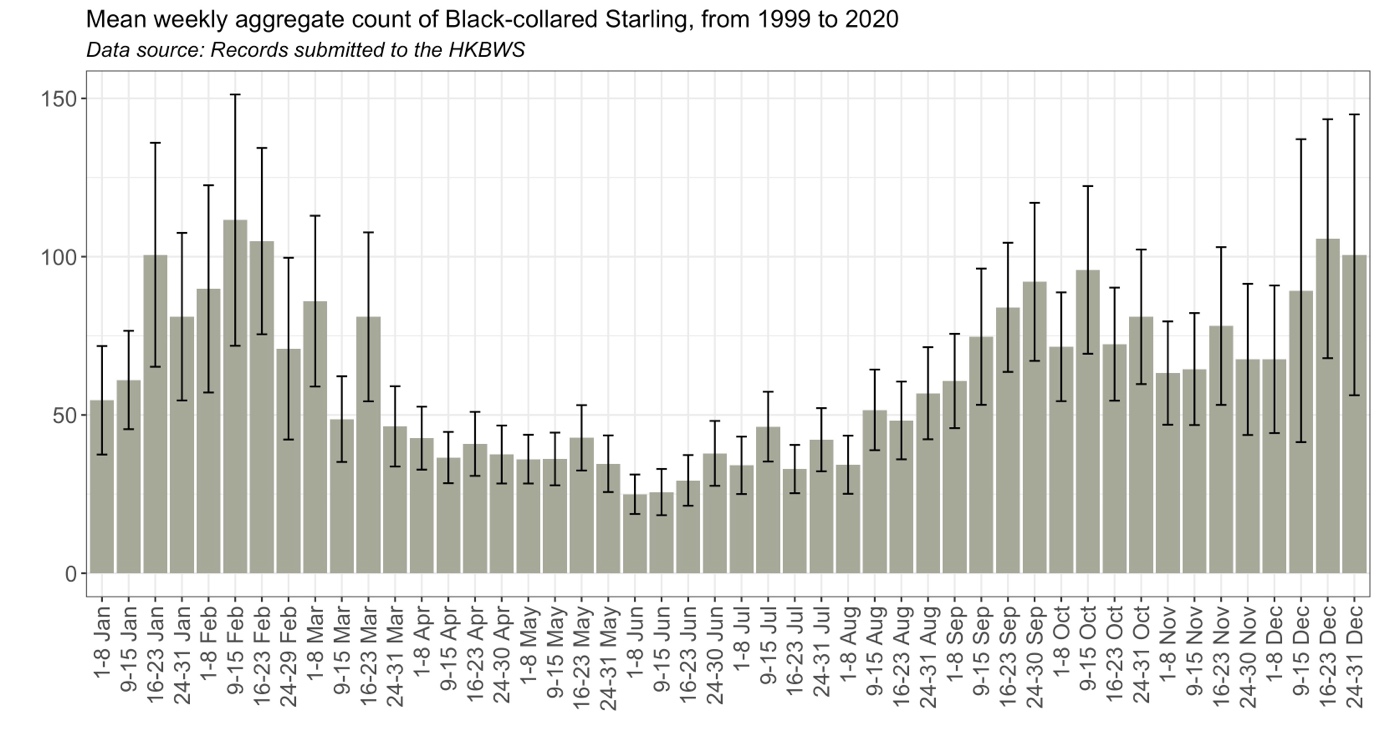Black-collared Starling Gracupica nigricollis黑領椋鳥
Category I. Common, widespread resident of lowland open-country, village and urban habitats.
IDENTIFICATION

May 2019, Kenneth Lam. Adult.
27–31 cm. Large highly vocal pied starling. Head and throat white, broad collar around neck down to upper breast black, mantle and back dark brown, rump white. Wing blackish, secondaries and wing coverts tipped white, tail chocolate-brown with white tip, broader on outermost feathers. Lower breast, belly and undertail-coverts white, often tinged with grey-brown. Bare yellow skin around eye extends in triangle behind eye; bill blackish; legs lead-grey to dull purplish brown.
Sexes alike. Juvenile lacks black collar, has head, neck and breast brownish grey, streaked white, back browner than adult.
VOCALISATIONS
A highly vocal species with a wide repertoire of sounds.
DISTRIBUTION & HABITAT PREFERENCE
Common and widespread in urban and suburban areas. Abundant in agricultural areas and on the fringes of villages and marshes in the northwest New Territories, and readily utilizes open storage areas, construction sites and derelict land. Also penetrates into the dense urban areas of HK Island, Kowloon, Lantau and other populated islands. It requires parks or other green spaces for foraging and is thus not as ubiquitous as Crested Myna. Similar to other starlings and mynas, it avoids forest, closed-canopy shrubland. Also rare in the hills.
Early historical records of Black-collared Starling are vague. Swinhoe (1861) recorded this species but his cryptic reference to its being rarer (in the Pearl River region) than in Amoy (Xiamen), means its status in HK at the time is uncertain. While the other early references made no specific reference to HK (Kershaw, 1904; Vaughan and Jones, 1913), Hutson (1930) reported that it could be seen near almost every village in the New Territories.
There was a 21% range increase between the breeding bird surveys of 1993-96 and 2016-19 from 29.3% of surveyed grid squares to 35.5%. However, there was not a comparable range change in the winter atlas, with only a 2% range increase between the surveys of 2001-05 and 2016-19 from 30.3% of surveyed grids to 31.0%. Similar to the Crested Myna, despite a reduction in the area of open habitats in the New Territories in the last two decades, Black-collared Starling has managed to expand its range within the available habitats due to its tolerance of urbanisation.
OCCURRENCE
Black-collared Starling is a sedentary species with no known migratory movements. Flock size is generally higher in the non-breeding season. In breeding season they begin to pair-up and raising chicks so that their numbers appear to be lower (Figure 1).
Although Black-collared Starling appears to have increased its population size since 1999 (Figure 2), it is not clear to what extent this is due to increased reporting in tandem with increased observer activity and greater use of eBird. The annual peak count in many localities has increased steadily, especially the northwest New Territories. A population increase was also noted at Shek Kong, Lantau (e.g., Pui O), Shuen Wan and HK Island (Victoria Park) but the numbers are smaller.
The highest count since 1999 is 812 birds at Mai Po on 10 December 2020 (the same flock stayed until late December). Other high counts at Mai Po include 675 on 20 January 2014 and 581 on 11 February 2014. Comparable high counts in other localities are rare, though 356 birds were reported at Tai Po Waterfront Park on 15 October 2013 and 317 at Long Valley on 10 September 2012.
BREEDING
Conspicuous, large domed nest constructed high in a tree. The breeding period can be very long, as nest building occurs almost throughout the year (nest building at Sha Tin on 28 February 2018 and Mai Po on 24 November 2019, with most reports from March to August. Juveniles are seen from May to September.
BEHAVIOUR, FORAGING & DIET
Sociable and gregarious, forming large evening roosts similar to other starlings and mynas. Feeds primarily on ground and is omnivorous; Herklots (1967) reported it following the plough consuming grubs. Dudgeon and Corlett (2004) observed it feeding at nectar-rich flowers such as Bombax ceiba and Erythrina sp. An adult was observed preying on a fledgling at Cha Kwo Ling on 30 April and 3 May 2020. Also seen feeding on ants in May.
RANGE & SYSTEMATICS
Monotypic. Occurs in Myanmar, south China, peninsular Thailand and south Indochina. Introduced in Taiwan, Peninsular Malaysia and Singapore (Craig and Feare 2020). In China occurs south of a line from Yunnan to Jiangsu, including Hainan (Liu and Chen 2020).
CONSERVATION STATUS
IUCN: Least Concern. Population trend increasing.
Figure 1.

Figure 2.

Craig, A. J. F. and C. J. Feare (2020). Black-collared Starling (Gracupica nigricollis), version 1.0. In Birds of the World (J. del Hoyo, A. Elliott, J. Sargatal, D. A. Christie, and E. de Juana, Editors). Cornell Lab of Ornithology, Ithaca, NY, USA. https://doi.org/10.2173/bow.bkcsta1.01
Dudgeon, D. and R. Corlett (2004). The Ecology and Biodiversity of Hong Kong. Friends of the Country Parks and Cosmos Books Ltd., Hong Kong.
Herklots, G. A. C. (1967). Hong Kong Birds (2nd ed.). South China Morning Post, Hong Kong.
Hutson, H. P. W. (1930). The birds of Hong Kong. Hong Kong Naturalist 1: 2-7.
Kershaw, J. C. (1904). List of birds of the Quangtung Coast, China. Ibis 1904: 235-248.
Liu, Y. and S. H. Chen (eds) (2021). The CNG Field Guide to the Birds of China (in Chinese). Hunan Science and Technology Publication House, Changsha.
Swinhoe, R. (1861). Notes on the ornithology of Hong Kong, Macao and Canton, made during the latter end of February, March, April, and the beginning of May 1860. Ibis 1861: 23-57.
Vaughan, R. E. and K. H. Jones. (1913). The bird of Hong Kong, Macao and the West River or Si Kiang in South-East China, with special reference to their nidification and seasonal movements. Ibis 1913: 17-76, 163-201, 351-384.

